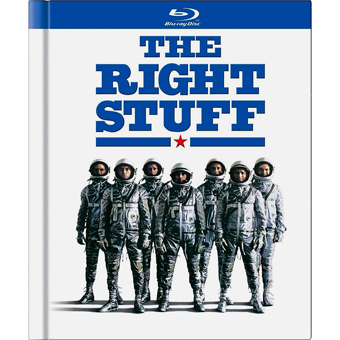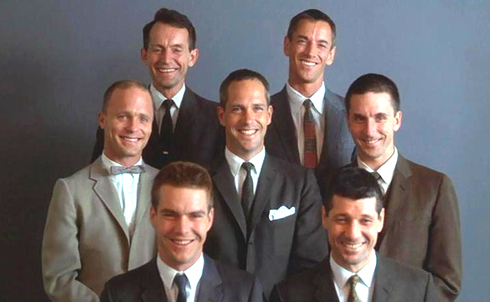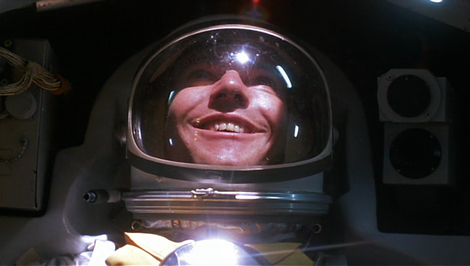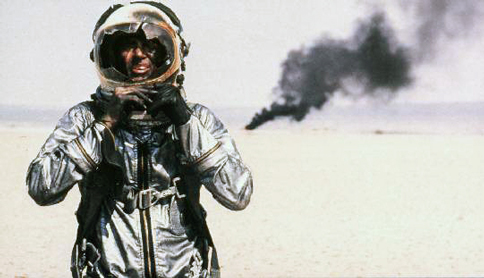|
|
The Right Stuff
Savant Blu-ray Review

|
The Right Stuff
Blu-ray
Warner Home Video
1983 / Color / 1:85 widescreen / min. / Street Date November 5, 2013 / 27.98
Starring Sam Shepard, Scott Glenn, Ed Harris, Dennis Quaid, Fred Ward, Barbara Hershey, Kim Stanley, Veronica Cartwright, Pamela Reed, Scott Paulin, Charles Frank, Lance Henriksen, Donald Moffat, Levon Helm, Mary Jo Deschanel, Scott Wilson, Kathy Baker, Mickey Crocker, Susan Kase, Mittie Smith, Royal Dano, David Clennon, Jeff Goldblum, Harry Shearer, Jane Dornacker, John P. Ryan, Eric Sevareid, Edward Anhalt, Peggy Davis, John Dehner, David Gulpilil, O-Lan Jones, Chuck Yeager.
Cinematography Caleb Deschanel
Film Editors Glenn Farr, Lisa Fruchtman, Tom Rolf, Stephen A. Rotter, Douglas Stewart
Production Design Geoffery Kirkland
Special Visual Creations Jordan Belson
Original Music Bill Conti
From the book by Tom Wolfe
Produced by Robert Chartoff, Irwin Winkler
Written and Directed by Philip Kaufman
|
|
|
|
|
Reviewed by Glenn Erickson
We could hardly believe it when Philip Kaufman's The Right Stuff failed to become a monster hit in 1983; the film took on the entire Mercury Program as documented in Tom Wolfe's highly readable book, surmounting all the problems inherent in heroic historical narratives. The very look of the film was inspiring, thanks to Caleb Deschanel's consistently riveting images and special effects that bettered then- trendy motion-control work. More importantly, the film is one of very few that expresses the spirit of the space program. It seemed as if all of America's technical resources and wealth were dedicated to a massive, nation-steering project that isn't directly about warfare. President Kennedy's constructive, idealistic moon challenge raised hopes that "the country that can do anything" might seriously pursue solutions to society's most difficult problems.
The seven Mercury Astronauts were veritable king's knights bred for high-tech combat in incredibly advanced, highly dangerous warplanes. The aces may have been killers with wings, but this batch were men compelled toward high risk, seeking to prove something about themselves. The audience I saw the show with on its first Saturday matinee laughed in all the right places. They were properly impressed by the sight of Chuck Yeager's rather unstable-looking rocket plane, fueling up on the dry lake bed safe a distance from buildings and personnel. It seemed both funny yet proper that the pilot of a million-dollar experimental craft should need a broom handle to secure its entry hatch, because he refused to report an injury to his arm. The Right Stuff rekindles optimism on an emotional scale remembered from American childhood dreams of idolized baseball heroes and cowboy stars. Navy aviator Alan Shepard (Scott Glenn) gets an offer to join a corps of space men willing to fly into unknown hazards. Shepard responds without hesitation: "Sounds dangerous --- count me in!" We applauded like John Wayne fans of olde.

The movie uses author Tom Wolfe's basic scheme of comparing the Mercury space men to the Air Force's military and civilian test pilots, the professionals that flew the experimental aircraft funded by the phenomenal defense boom of the 1950s. High above the Mojave Desert, most of these men risked their lives daily for not much more than regular flight pay and often in utter anonymity. They died by the dozens testing airframes and innovations in dozens of radical aircraft designs, some of which didn't get past the prototype stage. In contrast, Mercury space men were global celebrities from the moment their identities were announced, a new generation of noble warriors to challenge the heavens. With one look at their silver space suits we '50s kids felt certain that our destiny would be in outer space as well. The Mercury Program was science fiction -- but happening every night on the news.
The Right Stuff is docu-fiction expressing the spirit of Wolfe's book, not the exact truth. Its tone shifts from high drama, to knockabout comedy & satire, to a dreamy contemplation of the wonder of man's quest to fly. The major players are used to express different ideas. Chuck Yeager was a rambunctious and aggressive daredevil, a natural leader uncomfortable in the role of team player. Making brilliant use of actor Sam Shepard, Kaufman simplifies Yeager into a plain and simple Gary Cooper type, a 'natural man' following a higher vision. He's even given a western sidekick with the thickest drawl you ever heard, played by Levon Helm.
The first astronauts were highly disciplined fliers. They had bright personalities and were definite team players. Perhaps more ambitious than other flying officers, they were extremely competitive in their personal quest for achievement. Psychologists helped choose them for a special purpose -- to get the job done but also to promote an idealized image of American virtue. The Right Stuff takes license to externalize and amplify the personal traits Wolfe found in these gentlemen. All had a sense of humor, but Kaufman practically exaggerates their clowning. Dennis Quaid's Gordon Cooper is the class cut-up and Lance Henrickson is a moody Wally Schirra. Scott Glenn's Alan Shepard is given the warrior edge, while Charles Frank as Scott Carpenter is the sterling high achiever and best buddy. Fred Ward's Gus Grissom is a Fred Flintstone-like joker presented as if he had less imagination and less class than his compatriots. Gus takes a bunch of souvenirs along on his flight, and is made to act guilty when his space capsule malfunctions upon splashdown. Grissom is used to express the big truth of many military families, in which the wife not only gets a raw deal in lifestyle terms but ends up being taken for granted by a husband more interested in Beer Call. "What, no Jackie Kennedy?"
Finally, Ed Harris is phenomenally charismatic as the square's-square flying Marine John Glenn, a guy so motivated by virtue that he can't force himself to say 'damn'. A natural spokesman and motivator, when John speaks his words tumble out as gems of altruism, like Christopher Reeve as Superman. Unlike Gus Grissom, John is there backing up his wife all the way: "I'm behind you 100%!"
The big picture of the space race is presented in even broader comic terms, from Jeff Goldblum and Harry Shearer's goofball recruiters to the vintage news film edited to comic effect. A test capsule ejects with a feeble 'pop', like a champagne cork. Donald Moffat's broad lampoon of an apopleptic LBJ. is hilarious: "Gladiolas!" The astronaut applicants are put through batteries of gruesome, humiliating physical tests that provide an unending source of slapstick humor. Kaufmann even gets away with a sustained masturbation joke in this PG epic. The 'permanent press corps' is played by a comic troupe that turns every news and photo op into a silly circus. Kaufman overlays the sound of locusts to further characterize the press corps as parasites. Now is that fair to the journalists that served to promote the space program?

The story does distort some details. The narrative stresses the rebelliousness of the Astronauts against the rocket scientists -- "Our Germans are better than their Germans" -- when the relationship between the two groups was harmonious and cooperative to an extreme. The space men were often trained engineers, and their survival depended on excellent communication with the men tweaking the machinery. Out at Edwards, the flying being done by Chuck Yeager is made to look like a two-man operation, with Yeager deciding on his own when to hop in a plane and go break another speed or altitude record. It's part of the film's lionization of Yeager as the lonely, unappreciated hero who flies by a personal set of rules. That's mostly bunk. Yeager followed orders and had to work with a bureaucracy just like any other pilot. Had he gone to college, he'd have been elbowing his way into the Mercury program with the rest of them, defying anybody to scratch him on account of his age.
Off though some specifics may be, The Right Stuff conveys the full spirit of daring and adventure at the dawn of the space program, which otherwise might by now have been forgotten. (Really. Ask ten people under age fifty if they know what the X-15 was.) The show makes good use of old B&W shots of the Bell X-1 experiments and excellent color footage of missile tests and Mercury launches. Producers Chartoff and Winkler commissioned a number of motion control shots, but director Kaufman rejected many as too mechanical and unexciting. He ended up obtaining his dynamic "aircraft zooming" footage using models large and small: filmed outdoors, dropped from great heights and suspended before cameras running at multiple speeds. Twisting camera moves and buffeting motions provided dozens of short snippets of film that the editors assembled into jolting, impactful montages. The addition of powerful sound effects imparts even more excitement to the viewer.
Kaufman began as a footloose experimental filmmaker out of Chicago; his comedy sci-fi film Fearless Frank is the work of a director willing to try anything. To suggest an other-worldly awe experienced by pilots breaking the sound barrier or reaching outer space for the first time, Kaufman engaged the ethereal experimentalist Jordan Belson to create a weird light show effect, sort of a "star gate lite". We film students had ooh'd and ahh'd at abstract Belson short subjects like Samadhi and Allures when they were shown in traveling film exhibitions. Nobody had a clue how they were filmed, but Belson's signature visuals were immediately recognizable.
In between its fantastic visuals and fast-paced fun, The Right Stuff gives us a broad selection of marvelous characterizations. Old Royal Dano is the local man of the cloth, whose black-clad presence makes him a messenger of death whenever a pilot goes down. Kim Stanley is the amusingly vulgar Pancho Barnes, the proprietor of a high desert beer joint frequented by the fliers. Pamela Reed has fun clowning with Dennis Quaid, but reacts with horror when she imagines him the next pilot to be reduced to crushed cinders. Everybody seems to have wanted a part in this picture, no matter how small. Mickey Crocker, Susan Kase and Kathy Bates are "other" astronauts' wives, while Mary Jo Deschanel gets the plum role of the not-comfortable-speaking-in-public Annie Glenn. The likeable David Clennon tries to liaise between the Air Force and the new NASA, and perennial John P. Ryan loses a key argument with John Glenn. The go-to actor to play aborigines David Gulpilil befriends Gordo Cooper in a (to me) unnecessary "magic" episode in Australia. The Right Stuff suggests that unexplained sparkly objects seen by John Glenn in orbit were really cinders from a campfire in the Outback.

Chuck Yeager eventually speaks up in favor of the Astronauts' gallantry and bravery -- they've succeeded in piloting their craft rather than allowing the scientists to make them into passive 'specimens' relying on automatic systems. Philip Kaufman goes in for some daring thematic juxtapositions, almost all of which work. The boldest one inter-cuts Yeager's near-disastrous rocket plane flight with LBJ's big pork-barrel celebratory barbecue for the inauguration of the Houston Space Center. While Yeager's plane goes into a lethal spin up in the stratosphere, the Mercury Astronauts enter an arena in a parade, like conquering heroes. Gordo and Gus contemplate how good things are, when most of the seven have still yet to fly. To symbolize the "spirit of flight", Kaufman creates idealized images of Sally Rand performing a fan dance by Debussy. Back in the Mojave, the film's living spirit of flight Yeager counts himself happy to have survived: any landing one can walk away from is a good landing.
The participants give several reasons for the theatrical failure of The Right Stuff, despite the shower of accolades given it by the critics. Today, everybody loves it. I think that in 1983, only twenty years after the events pictured, Americans still had boring memories of Astronauts playing golf on the moon. Nobody remembered the near-disaster of Apollo 13. The kids wanted Luke Skywalker space fantasy, not a history lesson. Space was 'cool' for only a small tech-head segment of the country. It's too bad, because Philip Kaufman's movie is about as inspirational as an upright and patriotic film can get. 1
Warner Home Video's 30th Anniversary Blu-ray Edition of The Right Stuff should be shouting even louder that the movie is a modern classic. Plenty of us have been anticipating this release and are very happy to see it. Earlier DVDs were good but the added resolution and audio dynamics of HD make a big difference -- there's more oomph in the soundtrack when Yeager 'puts the spurs to it.' The prolific Bill Conti's music is a big plus, with his main theme a respectful ode to the astronauts.
As the three hour, thirteen-minute film fills the Blu-ray disc, Warners' extras are contained on a separate DVD, which may be the same exact item from the earlier special edition. Put together about ten years ago, the featurettes have spirited input from many of the actors, who are clearly proud of their participation in the movie. One of the featurettes gives us a selection of real Mercury astronauts discussing the picture and a few of its inaccuracies. They're real gentlemen.
On a scale of Excellent, Good, Fair, and Poor,
The Right Stuff Blu-ray rates:
Movie: Excellent
Video: Excellent
Sound: Excellent
Languages: English, French, Spanish
Supplements: Featurette-docus: John Glenn: American Hero; The Journey and the Mission; scene-specific commentaries with Philip Kaufman plus cast and crew members, three interview featurettes with the filmmakers, cast and the Mercury astronauts: Realizing the Right Stuff, T-20 Years and Counting and The Real Men with the Right Stuff; deleted scenes.
Deaf and Hearing-impaired Friendly?
YES; Subtitles: English, French, Spanish
Packaging: One Blu-ray and one DVD in Digi-book with glossy 25-page souvenir booklet.
Reviewed: October 24, 2013
Footnote:
1. I've explained this before, but I lived on Edwards Air Force Base during the film's time of the flight testing and experimentation, albeit at age 4-6. My father was the Chief Master Sergeant E9 in charge of the Edwards flight line, and was a participant in much of the "Yeager" section of the film. He told me that the test pilots he befriended positively impressed him, in particular Gordon Cooper, I believe. I played with my toy trucks in the dirt outside our on-base house while sonic booms blasted out five and six times an hour. A big base housing program must have occurred before we arrived, because my family residence neighborhood (the only part of the base I saw) was already pretty built-up by 1955. My father would work two and three days without sleep and then come home to crash for 14 hours straight. Little Eric (me) learned to be ver-ry quiet, I kid you not. We left for Hawaii in 1958, just as the X-15 program was getting into shape.
Return

DVD Savant Text © Copyright 2013 Glenn Erickson
See more exclusive reviews on the Savant Main Page.
Reviews on the Savant main site have additional credits information and are often updated and annotated with reader input and graphics.
Also, don't forget the
2011 Savant Wish List.
T'was Ever Thus.
Return to Top of Page
|

